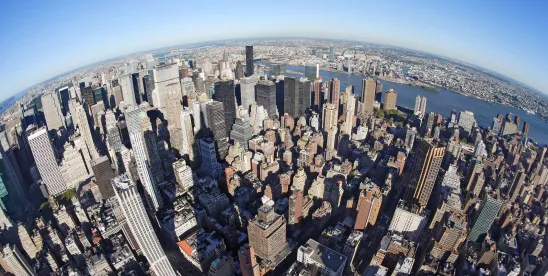On Sept. 11, 2023, the City Planning Commission approved amendments to the New York City Zoning Resolution, called “City of Yes for Carbon Neutrality,” proposed by Mayor Adams’ administration to advance the city’s climate goals, including an 80% reduction in carbon emissions by 2050. The changes are designed to support a renewable energy grid, make buildings more energy efficient, support the use of electric vehicles, and reduce waste and stormwater runoff. Policymakers and stakeholders have long advocated for updating the Zoning Resolution, which was enacted in 1961, to facilitate modern green technologies such as solar panels and electric vehicles. The proposal will now advance to the City Council for final approval. The proposed zoning changes are as follows:
-
To facilitate placement of solar panels on rooftops, revise the “permitted obstruction” regulations to remove building coverage limits and setback requirements for rooftop solar panels, and apply a 15-foot maximum height limit to all solar installations on flat roofs and a 5-foot height limit on sloped roofs (ZR 23-621).
-
Allow solar awnings and canopies to cover parking areas by adding them as “permitted obstructions” in open space, not to exceed a height of 15 feet above grade (ZR 23-12).
-
Create the newly defined use “energy infrastructure equipment” (EIE), and add it to Use Groups 4, 6, and 14 (ZR 12-10, 22-14, 32-15, 32-23). EIE includes renewable energy systems, such as solar or wind energy, and energy storage systems, such as fuel cells and batteries (ZR 12-10). This infrastructure would be as-of-right in Residence Districts, if no more than 10,000 square feet of lot area, and as-of-right in Commercial and Manufacturing Districts, at any size. Currently, a Board of Standards and Appeals special permit is needed for “electric utility substations” to be located in Residence Districts, and would still be required for all EIE of more than 10,000 square feet of lot area in Residence Districts (ZR 73-14).
-
Create a new City Planning Commission authorization to modify waterfront bulk and public access area regulations to accommodate wind energy systems (i.e., onshore wind turbines) (ZR 62-825).
-
Certain allowances for permitted obstructions that currently apply only within flood zones would apply citywide, increasing the maximum allowed lot coverage and height for such equipment to up to 50% of the building’s lot coverage at 15 feet above the maximum building height, and up to 30% of the building’s lot coverage at 25 to 55 feet above the maximum building height, depending on the zoning district (ZR 23-662(c)). This will provide greater flexibility for electric equipment such as heat pumps.
-
To facilitate façade replacement and recladding for energy efficiency, create a new exemption from zoning floor area for additional wall thickness, provided the new wall complies with the latest thermal barrier requirements in the NYC Energy Code (ZR 12-10).
-
Update the existing “Zone Green” floor area deduction by providing a 5% deduction from zoning floor area for existing buildings that are “fully-electrified buildings” and new buildings designed as “ultra-low energy buildings.” A “fully-electrified building” is an existing building that complies or is retrofitted to comply with the requirements of Local Law 154 of 2021. Local Law 154’s requirements will apply to new buildings submitting a DOB application for approval of construction documents as of July 1, 2027. An “ultra-low energy building,” in addition to complying with Local Law 154, is a new building no greater than three stories that is a net-zero energy building which must produce energy onsite from renewable energy sources in an amount equal to or greater than such building’s total energy needs, or a new building greater than three stories that has (i) an energy use intensity that is no greater than 50% or more below the energy use intensity of such a building if designed and constructed according to one of the approved modeling methods in ASHRAE 90.1, or (ii) a source energy use intensity not more than 38 kBTU per square foot per year (ZR 12-10).
-
Reclassify electric vehicle charging facilities as a Use Group 6 and Use Group 14 use rather than Use Group 7, to be permitted as-of-right in all Commercial Districts (in addition to Manufacturing Districts, as currently allowed) (ZR 32-15 and 32-23), and allow electric vehicle charging facilities at all accessory off-street parking spaces (ZR 25-44).
-
Expand existing regulations allowing car sharing spaces in accessory parking facilities to allow facility owners to designate up to 20% of spaces (or 5, whichever is greater) for publicly available electric vehicle “charger sharing,” or car sharing, or any combination thereof (ZR 25-42).
-
In most Commercial Districts and all Manufacturing Districts, allow up to 20% of accessory parking spaces (or 5, whichever is greater) to be occupied by (1) car share vehicles, (2) car rental vehicles, (3) public electric vehicle charging spaces, or (4) commercial vehicle storage for vehicles not exceeding 20 feet in length, or any combination thereof (ZR 36-41).
-
To support the growth of automated parking facilities, a 153-square foot floor area allocation per parking space in automated parking facilities would be applicable citywide. This allocation currently applies in the Manhattan Core and certain other designated areas (ZR 25-626).
-
Create a new commercial use for public bicycle and micromobility parking (ZR 32-15, 32-23), and provide that outdoor bike storage lockers are permitted obstructions in yards and open spaces (ZR 23-441).
-
Clarify that any paving area may be paved with permeable paving (ZR 25-65).
-
Allow required street trees to be planted within connected tree beds per DOT standards or raingardens per DEP standards, and allow a DEP-compliant raingarden as a substitute for a required street tree (ZR 26-41).
-
Clarify that (1) composting can be an “accessory use” (ZR 12-10), (2) recycling or organic material receiving facilities of up to 5,000 square feet per establishment are allowed in all Commercial Districts (Use Groups 6 and 14) (ZR 32-15, 32-23), and (3) larger composting and recycling facilities remain restricted to Manufacturing Districts (Use Groups 17 and 18 (ZR 42-14, 42-15)). The Zoning Resolution currently does not mention “recycling” or “composting.”
-
Allow qualifying rooftop greenhouses to be added on top of non-residential buildings as-of-right, which are not counted as zoning floor area and are allowed to exceed the maximum permitted building height, eliminating the City Planning Commission Certification currently required for rooftop greenhouses in ZR 75-01 (ZR 12-10).



 />i
/>i

